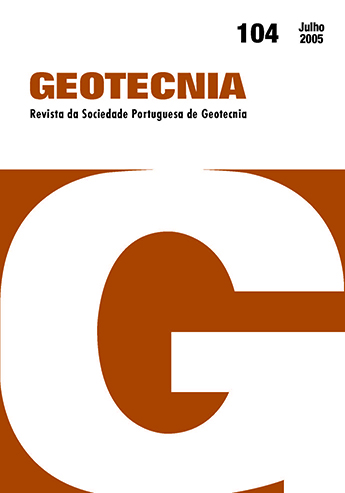Saturation process in triaxial tests
DOI:
https://doi.org/10.14195/2184-8394_104_3Abstract
Within the scope of study of the behaviour of granite residual soils of Porto for their use as capping layer for pavements, triaxial tests under drained isotropic consolidation were carried out over compacted samples. An important part of this process consisted of obtaining the complete saturation of the soil sample, prior to the loading test stages, in order to simulate the most adverse conditions to which the pavement will be subjected to in operation, that is, with the full saturation of the embankment. Another important fact must be added, which is the need to ensure that the stress analysis is made with guaranteed full control of the two components: pore pressure and effective stress, and that the former is not actually affected by unaccountable suction values. As a result of this study, during the course of this work and because of the vagueness in the vast international literature (inclusive in testing standards) on this issue of effectively ensuring full saturation, several sample saturation processes were used in order to find the most suitable method for this particular case. In what follows, these subjects are described in detail.
Downloads
References
AASHTO (1998). Standard Specifications for Transportation Materials and Methods of Sampling and Testing- Part I & Part II. American Association of State Highway and Transportation Officials, 19th edition.
ASTM D 2487-93 (1997). Standard Classification of Soils for Engineering Purpose (Unified Soil Classification System), Annual Book of ASTM Standards, Vol. 04.08.
Baldi, G., Hight, D. W. y Thomas, G. E. (1988). A Reevaluation of Conventional Triaxial Test Methods. Advanced Triaxial Testing of Soils and Rocks, ASTM STP 977. Robert T., Donaghe Ronald C., Chaney and Marshall L. Silver, Eds., American Society for Testing and Materials, Philadelphia, pp 219-263.
Bishop A. W. y Henkel, D. J. (1962). The Measurement of Soil Properties in the Triaxial Test, London.
Ferreira, C. (2003). Implementação e Aplicação de Transdutores Piezoeléctricos na Determinação de Velocidades de Ondas Sísmicas em Provetes. Avaliação da Qualidade de Amostragem em Solos Residuais. Dissertação apresentada na Universidade de Porto para obtenção do grau de Mestre, FEUP, Porto.
Ishiara, K., Tsuchiya H., Huang, Y. y Kamda K. (2001). Recent Studies on Liquefaction Resistence of Sand- Effect of Saturation (Keynote Lecture). Proceedings of the 4th International Conference on Recent Advances in Geotechnical Earthquake Engineering and Soil dynamics, San Diego, California.
Lacasse, S. y Berre, T. (1988). Triaxial Testing of Soils and Rocks, ASTM STP 977, Robert T., Donaghe Ronald C., Chaney and Marshall L. Silver, Eds., American Society for Testing and Materials, Philadelphia, pp. 219-263.
Rad, S. N. y Clough, G.W. (1984). New procedure for saturating sand specimens. Journal of the Geotechnical Engineering Division, American Society of Civil Engineers, Vol. 110, No. 9, pp. 1205-1218.
The Japanese Geotechnical Society (1999). Standards of Japanese Geotechnical Society for Laboratory Shear test, English Version, pp 3-7.
Viana da Fonseca, A. y Ferreira, C. (2002). Bender Elements como Técnicas Laboratoriais Excelentes para Avaliação de Parâmetros Geotécnicos Referenciais, 8º Congresso Nacional de Geotecnia, LNEC, Lisboa, Vol. I, pp. 353-365.
Viana da Fonseca, A. y Ferreira, C. (2003) Aplicação da Técnica de Bender Elements para Avaliação da Qualidade de Amostragem em Solos Residuais, XII COBRAMSEG, São Paulo, Brasil, pp.187-199.
Yang, J. (2002). Liquefaction Resistance of Sand in Relation to P-wave Velocity, Géotechnique, Vol. 52, Nº 4, pp. 295-298




